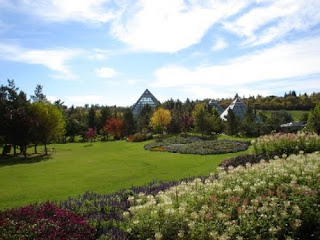Driving through the neighborhoods in Edmonton, I've noticed many trees that have been flagged by the city for replacement. The last few years of drought have taken their toll on the elms, birch and chokecherries planted on boulevards and in parks and parking lots. Many spruce show signs of water deprivation with reddish brown needles. Evans cherries had a tough go of it this winter. Many didn't make it through or suffered severe dieback. The prevention - water! So many times we had customers come to the greenhouse with samples and stories of drought ridden trees only to be told that watering would have made all the difference. Rain is not sufficient most of the time. We need to supplement, particularly during hot spells and in the fall to settle them in for winter. Folks, water your gardens (trees, shrubs, perennials) in the fall until the time the ground freezes. You want to create an ice block, upon freezing, that will slowly melt in the spring thaw and aid your tree with moisture that is badly needed. This also helps prevent the freeze/thaw effect that our spring brings.
In Edmonton there is a fine collection of healthy American elm trees, one of the largest concentrations in the world unaffected by Dutch Elm Disease. Other trees that have proven to be hardy here are: Jack Pine, Lodgepole Pine, White Spruce, White Birch, Aspen, Mountain Ash, Amur Maple, Russian Olive, Green Ash, Basswood, Various Poplars and Willows, Flowering Crabapple, Mayday Tree and Manitoba Maple. An increase in popularity in Bur oak, Silver Maple, Hawthorn and Ohio Buckeye is becoming evident. Other species introduced include White Ash, Blue Spruce, Norway Maple, Red Oak, Sugar Maple, Common Horse-Chestnut, McIntosh Apple, and Evans Cherry. Three walnut species have survived in Edmonton including Butternut (with the best survival rate of the walnut species here), Manchurian walnut, and black walnut. For a variety of hardy fruit trees and ornamentals available and hardy for zone 3, check with your local reputable garden center. (source: Wikipedia, June 2010 and greenhouse sales) See also: http://www.edmonton.ca/environmental/conservation_landscaping/selection-list-of-common-tree.aspx



3 comments:
Is your birch tree dying from the top down? It is most likely linked to drought conditions. Birch love moisture!! Many in my neighborhood are twiggy up top and leafy about 2/3 of the way down. Sadly, this cannot be corrected. Get an arborist to come in and remove the upper dead portion and be prepared to increase the watering. Sometimes, the damage is too far gone and the tree cannot recover thus slowly dying back a little more each year. Sorry to say, it will have to be removed if it reaches this state.
To my readers in Alaska: which area do you live in? Are you zone 2 or 1? I will be doing an article in the near future about pushing the zone boundaries and gardening in colder climates.
http://www.flickr.com/photos/23840945@N05/
has photos of great trees growing in Edmonton! Check it out!!
Post a Comment